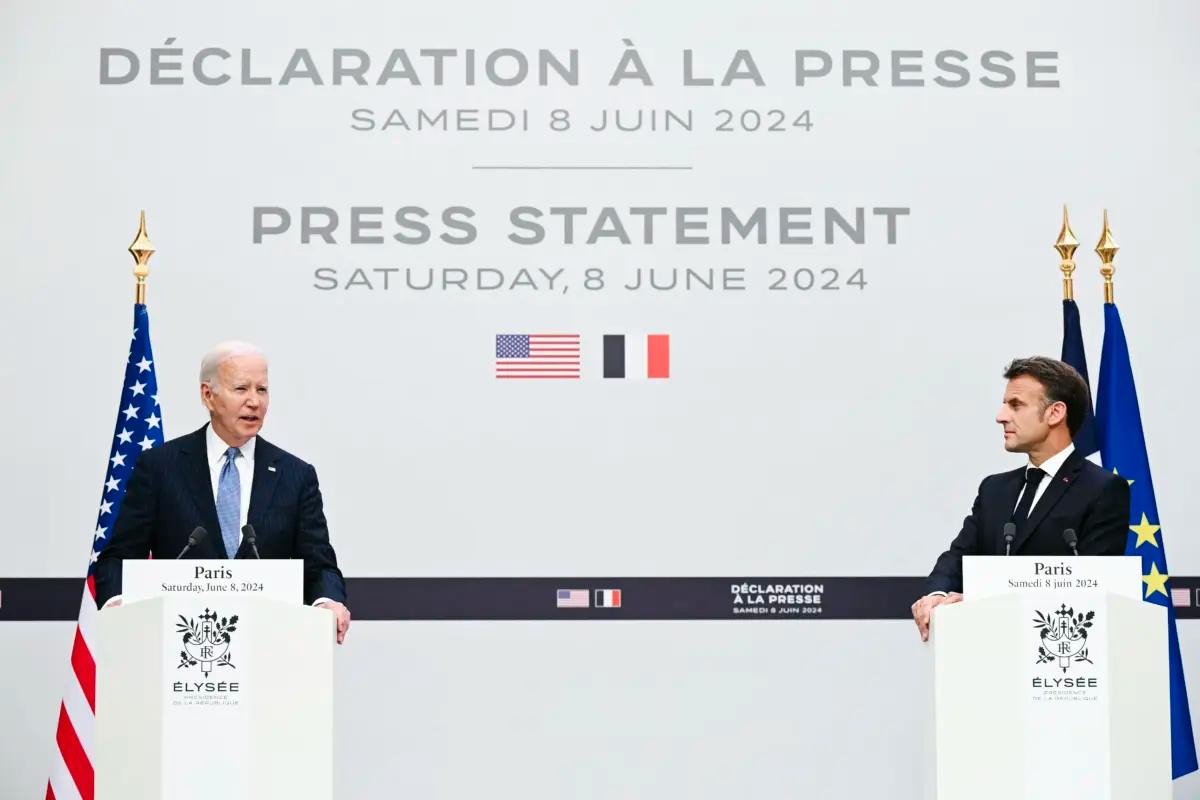The president used his D-Day visit to Normandy to promote democratic values and the importance of alliances such as NATO.
PARIS—President Joe Biden concluded his visit to France in a heated election year, hoping that his remarks about democracy and the perils of isolationism will resonate with American voters.
Before his departure back home, President Biden told reporters that his “most remarkable” visit aimed to help Americans understand the significance of maintaining strong alliances to avert a third world war.
“Do not break,” he urged. “Do not break.”
This was a core message he reiterated throughout his five-day visit to France.
On June 6, President Biden kicked off his visit by marking the 80th anniversary of D-Day, the Allied invasion that played a pivotal role in freeing Europe from Nazi Germany’s control.
At the Normandy American Cemetery, he attended a nearly three-hour ceremony honoring those killed during D-Day and the Battle of Normandy.
“Democracy is never guaranteed. Every generation must preserve it, defend it, and fight for it. That’s the test of the ages,” President Biden said during a speech on a podium flanked by roughly 180 U.S. World War II veterans ranging in age from 95 to 103.
“Isolation was not the answer 80 years ago and is not the answer today.”
He made the comments while defending the NATO alliance.
On June 7, he traveled to Pointe du Hoc, France, on the Normandy coast to give another speech about democracy. He stood atop a sheer cliff in front of the U.S. Ranger Monument, right where President Ronald Reagan delivered his iconic D-Day memorial speech 40 years ago.
“They’re not asking us to scale these cliffs, but they’re asking us to stay true to what America stands for,” President Biden said of the U.S. Army Rangers who scaled the 100-foot cliffs to disable the heavily fortified German positions at Pointe du Hoc.
“They’re asking us to do our job: to protect freedom in our time, to defend democracy, to stand up to aggression abroad and at home, to be part of something bigger than ourselves.”
President Biden drew comparisons between World War II and the war in Ukraine, echoing President Reagan by emphasizing the importance of fighting together with allies against tyranny.
President Reagan, like President Biden, was running for reelection when he gave his memorable D-Day speech. And, like President Biden, he was dealing with a difficult economic situation at home.
While inflation had dropped from its peak in 1980 of nearly 15 percent, it was still above 4 percent when he gave his Pointe Du Hoc speech in June 1984.
Ukraine Dominates State Visit
Amid a packed schedule, President Biden met with Ukrainian President Volodymyr Zelenskyy, who also participated in the D-Day commemorations in Normandy.
During their meeting on June 7, he apologized to the Ukrainian president for delays in the passage of a foreign aid bill that included $61 billion in assistance for Ukraine.
“We’re not going to walk away from you,” President Biden told Mr. Zelenskyy, announcing $225 million in new assistance for the war-torn country.
Ukraine was at the top of President Biden’s agenda when he met with French President Emmanuel Macron on June 8 at Elysée Palace as part of his state visit.
During a joint statement, Mr. Macron said both leaders “see eye to eye” on support for Ukraine.
He said both leaders agreed to permit Ukraine to fight back against Russia while defending its territory.
Both leaders discussed a wide range of pressing issues during their bilateral meeting, including the war in the Middle East, as well as China’s industrial overcapacity and aggression in the Indo-Pacific.
“This week, we have shown the world once again the power of allies and what we can achieve when we stand together,” President Biden said during the event.

Before the state visit, the main point of contention was the release of Russian assets held in European accounts for potential use in Ukraine, particularly for reconstruction. France was the main holdout on the plan.
However, President Biden indicated before he left the country that both leaders had reached an agreement on a plan to use the frozen Russian assets.
Before their bilateral meeting, Mr. Macron and his wife, Brigitte Macron, hosted a welcome ceremony for the U.S. president and First Lady Jill Biden at the Arc de Triomphe in Paris, an iconic symbol of France that honors those who fought and died in the French Revolutionary and Napoleonic Wars.
As a “student of French history,” President Biden said during the press statement, it was “a moving experience” for him to attend the Arc de Triomphe welcome ceremony.
He later remarked at a lavish state banquet that Mr. Macron hosted, “This has been the most remarkable trip I’ve ever made.”
The World War I Cemetery
Before returning to the United States, the president and first lady visited Belleau, France, about 60 miles from Paris, to lay a wreath at the Aisne-Marne American Cemetery, a World War I cemetery.
During his visit to the cemetery, President Biden once again emphasized the importance of alliances such as NATO.
“Even though I’ve been here before, it surprised me how much it awakened my sense of why it’s so valuable to have these alliances, why it’s so critical,” President Biden said.
“That’s the way you stop wars, not start wars.”










